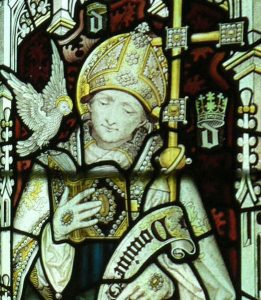1 March – St David's Day
1st March is the feast day of St David (Dewi Sant), patron saint of Wales. According to Rhigyfarch’s Life of Saint David, David lived in the 6th century and founded religious centres including Glastonbury and Croyland. He then travelled to the Holy Land and was made archbishop at Jerusalem before travelling back to Wales and settling at Glyn Rhosyn (Rose Vale), or St David’s, in Pembrokeshire, Wales. There, he founded a monastery whose site is now marked by St David’s Cathedral.
Dewi (David) and his community were said to have performed many miracles which included Dewi causing the ground to rise beneath him while preaching at the Synod of Llanddewibrefi so that everyone could see him.
Dewi died in 589 and was recognised as a Catholic saint in 1120. His feast day, 1st March, is now no longer a religious feast but is a national celebration of Wales and Welsh identity. It is traditional for Welsh people to wear a daffodil or leek on 1st March, and the leek as a symbol of Wales is linked to two legends:
- The legend of the soldiers of the ancient British king, Cadwaladyr, wearing leeks so that they would know who their comrades were in battle.
- The legend that the Welsh archers fought in a field of leeks at the Battle of Crécy in 1346 when Edward, Prince of Wales, defeated France. It was said that Welshmen then wore leeks on their caps on St David’s Day to remember the courage of the archers.
Steve Roud, in The English Year, points out how William Shakespeare's Henry V (1599), has a scene “in which the English braggart Pistol makes fun of the Welsh captain Fluellen's wearing of a leek on St David's Day, and is forced to eat the vegetable, skin and all.” Roud also writes of how, in the 17th century, Samuel Pepys recorded in his diary for March 1667 the practice of hanging out dolls and scarecrows with leeks on their heads, and calling out after Welshmen “Taffey” or “David” to tease them.
W. Carew Hazlitt, in the book Faith and Folklores, writes of how King Henry VII “having Welsh blood in his veins” felt particularly obliged to observe the feast day and records show that he paid £2 one March for a feast for Welshmen. According to the Privy Purse Expenses of Henry VIII’s daughter, Princess Mary, she was presented with a leek by yeoman of the guard on the feast day in 1537, 1538 and 1544. Here's the record of a payment made to the Yeoman of the Guard in 1544:
“Itm gevin to a yeoman of the garde for bringing a Leeke on saint Davys day - xv s.”
25 March – Lady Day, or the Feast of the Annunciation of the Blessed Virgin
Lady Day, or the Feast of the Annunciation of the Blessed Virgin, was a feast day commemorating the day that the Virgin Mary was first told by the Angel Gabriel that she was carrying Jesus. It is, of course, nine months before Christmas Day, the day in which Christ was born.
Lady Day was the first day of the calendar year in England until 1752, when the first day of the year was changed to 1 January and the Gregorian Calendar replaced the Julian Calendar. Although the calendar year officially started on 25 March in Tudor times, New Year’s gifts were still given on 1 January, which came from the Roman tradition of New Year.
Historians and researchers have to bear Lady Day in mind when reading primary sources and reading things like tomb inscriptions. For example, according to primary sources Thomas Boleyn died in 1538 and Lady Jane Grey was executed in 1553, but this is because their deaths took place before Lady Day that year. When we take into account the modern calendar, Thomas and Jane died in 1539 and 1554 respectively.
On Lady Day in 1555, during Mary I’s reign, diarist Henry Machyn recorded jousting at Westminster which was in celebration of the feast day:
The xxv day of Marche, the wyche was owre lade [day,] ther was as gret justes as youe have sene at the tylt at Vestmynster; the chalyngers was a Spaneard and ser Gorge Haward; and all ther men, and ther horsses trymmyd in whyt, and then cam the Kyng and a gret mene [menée or retinue] all in bluw, and trymmyd with yelow, and ther elmets with gret tuyffes [tufts or plumes] of blue and yelow fether, and all ther veffelers [whifflers or forerunners] and ther fotemen, and ther armorers, and a compene lyke Turkes red [rode] in cremesun saten gownes and capes, and with fachyons [falchions] and gret targets; and sum in gren, and mony of clyvers colers; and ther was broken ij hondred stayffes and a-boyff [above].
The only knight named is Sir George Howard, but the knights were both English and Spanish, and a record two hundred staffs were broken.
Trivia: The UK tax year starts on 6th April which dates back to 1753 when rents were due on Lady Day (it was a Sunday so the taxes were due on 26th March), the old New Year, but because 11 days were skipped due to the implementation of the new Gregorian Calendar they became due on 6th April.
29, 30 and 31 March – Borrowed Days
As an article on the Independent.ie website explains, “March is one of those months around which lots of weather lore has accumulated. Its final three days were often called ‘the borrowed days’. It was believed that they had been borrowed by March from April. They were considered to be days of wintry relapse and of ill-omen when no enterprise was willingly begun.” The article goes on to explain that “The origins of the story are given in verse-form in the folk-wisdom of Scotland:
‘March said to Aperill,/ I see three hoggs upon a hill,
And if you'll lend me dayes three,/ I'll find a way to make them dee.
The first o’ them was wind and weet,/ The second o’ them was snaw and sleet,
The third o’ them was sich a freeze,/ It froze the birds’ nebs to the trees:
When the three days were past and gave,/ The three silly hoggs came hirpling hame.’”
Steve Roud gives an early 18th century quote regarding these borrowed days and their “blustering weather” and how people “would wish to borrow three days from the month of April in exchange for the last days of March.” (c.1709) Although I haven't found mention in English 16th century records of these “borrowed days”, Roud believes that the traditional saying dates back to the at least the mid-sixteenth century in the British Isles, so perhaps it was just in Scotland and Ireland.



Leave a Reply